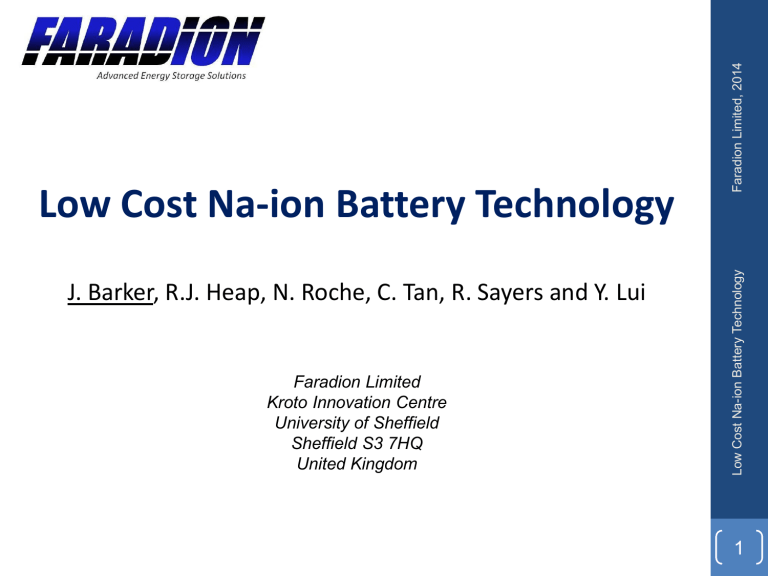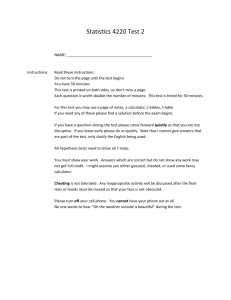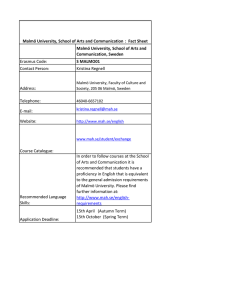Low Cost Na-ion Battery Technology
advertisement

J. Barker, R.J. Heap, N. Roche, C. Tan, R. Sayers and Y. Lui Faradion Limited Kroto Innovation Centre University of Sheffield Sheffield S3 7HQ United Kingdom Faradion Limited, 2014 Low Cost Na-ion Battery Technology Low Cost Na-ion Battery Technology 1 Faradion Limited, 2014 Company Introduction Faradion Limited is an early stage company (est. 2011) engaged in the development of low-cost, non-aqueous sodium-ion (Naion) rechargeable batteries for automotive, utility and consumer sectors. Low Cost Na-ion Battery Technology Faradion has also developed low-cost methods for the synthesis of LiFePO4 and other active materials. These methods will allow the manufacture of the lowest cost LiFePO4 in the industry, while still retaining outstanding electrochemical and safety performance. (Abstract#996 - October 29, 10:40 h) During its screening of new Na-ion cathode materials, the companyNon-aqueous has discoveredNa-ion a number of novel Li-ion cathode Battery Technology phases. 2 2 Oxford, England . . Faradion Limited, 2014 Sheffield, England Low Cost Na-ion Battery Technology Company Locations in UK 3 Low Cost Na-ion Battery Technology Na-ion Batteries: Background 4 Faradion Limited, 2014 Sodium 0.98 23.0 0.3 180 98 <0.005 7000 Tet/Oct 2.6 <200 Oct/Prismatic Cathode Materials Layered Oxides, Spinels, Polyanions, Halides etc. Layered Oxides, Polyanions, Halides etc. Anode Materials Graphite, Hard Carbon, Oxides, Composites, Conversion etc. Hard Carbon, Oxides, Composites, Conversion etc. IP Position (Battery Materials) Complex Simpler E0 vs Li/Li+ o Melting Point [ C] Natural Abundance in Earth's Crust [%] Carbonate Cost [$/tonne] Ion Co-ordination Faradion Limited, 2014 Lithium 0.76 6.9 0.0 Property Ionic Radius [Å] Atomic Mass [g/mol] Low Cost Na-ion Battery Technology Properties: Li vs. Na 5 Faradion Electrolyte + Separator + Al (cc) Faradion Hard Carbon Al(cc) Faradion Cathode 4 cm2 or 100 cm2 Typical Faradion Na-ion Pouch Cells Low Cost Na-ion Battery Technology - Faradion Limited, 2014 Na-ion Pouch Cells Typical cell capacity = 10-12 mAh (4 cm2) and 250-300 mAh (100 cm2) Typical Bi-cell capacity = 500-600 mAh (100 cm2) 6 S-Y-Hong et al. Energy Environ Sci. 2013 DOI: 10.1039/C3EE40811F Faradion Limited, 2014 • Anode: Hard Carbons (Commercial and Proprietary) • Electrolyte: Typically NaClO4-PC or NaPF6 EC/DXC/PC • Cathode: More than 90 classes of novel active materials screened so far! 1. Polyanions: Phosphates 2. Na3M2XO6 and Na2M2X’O6: O3 and P2 structural types 3. Layered Oxides: O3-structural types We want to be here! Low Cost Na-ion Battery Technology Faradion Cell Chemistry 7 Low Cost Na-ion Battery Technology Anode Materials 8 Faradion Limited, 2014 1000-1200oC Nitrogen 250-350oC Air Faradion Limited, 2014 Hard Carbon Synthesis De-water Foam Milling Fine Powder Pressing Pellet Pyrolysis and milling Fine Powder [20-100 g scale] Schematic: Example Preparative Route for Faradion Hard Carbon Low Cost Na-ion Battery Technology Carbohydrate 9 Broad reflections indicate the disordered nature of the HC Commercial Faradion Limited, 2014 XRD Profiles Low Cost Na-ion Battery Technology Parallel stacks of graphene sheets, d002 spacing ~ 3.8 Å cf Graphite = 3.35 Å XRD (CuKα) Profiles for Commercial and Faradion Hard Carbons 10 (B) Na insertion into nano-pores 1.5 1.0 0.5 300 250 200 150 100 50 0 0 0 50 100 150 200 250 300 350 400 Low Cost Na-ion Battery Technology (A) Na insertion 2.5 into graphene interlayer space 2.0 Reversible Specific Capacity [ mAh/g] Electrode Potential [V vs. Na] Typical particle sizes = 2-8 μm Faradion Limited, 2014 Hard Carbon: Faradion 1 2 3 4 5 6 7 8 9 10 Cycle Number Specific Capacity [mAh/g] Faradion Hard Carbon vs. Na = 280 mAh/g FCL = 26% 11 Low Cost Na-ion Battery Technology Cathode Materials 12 Faradion Limited, 2014 Phosphates Na7M4(P2O7)4PO4 Na7M3(P2O7)3 Na4M3(PO4)2P2O7 Na3M2XO6 Na2M2X’O6 O3-Na3Ni2SbO6 P2-Na2Ni2TeO6 Layered Oxides NaNi1-x-y-zM1xM2yM3zO2 Faradion Limited, 2014 Database of Na Cathode Materials > 90 classes in total Low Cost Na-ion Battery Technology Na Cathodes 13 Low Cost Na-ion Battery Technology Phosphates 14 Faradion Limited, 2014 • • • • Na7M4(P2O7)4PO4; M = V, Fe, Cr, Al etc. 3D framework of MO6 octahedra, P2O7 groups + isolated PO4 tetrahedra Na+ ions (3 sites) located within cavities in the 3D framework Tetragonal structure, space group P421c 4000 3000 4 3 2 1 0 20 40 60 80 100 Cathode Specific Capacity [mAh/g] 120 2000 1000 0 -1000 -2000 -3000 -4000 2.5 3.0 3.5 4.0 4.5 Electrode Potential [V vs. Na] Na7V4(P2O7)4PO4 vs. Na • Theoretical specific capacity (6 Na per FU; V3+ V5+) = 162 mAh/g • Achievable reversible specific capacity = 58 mAh/g Low Cost Na-ion Battery Technology Electrdeo Potential [V vs Na] -1 Differential Capacity, dQ/dV [mAh g /V] 5 Faradion Limited, 2014 Na7M4(P2O7)4PO4 15 Na4M3(PO4)2P2O7; M = Fe, Co, Ni, Mn etc. 3D framework of PO4 tetrahedra, MO6 octahedra and P2O7 groups. Na+ ions (4 sites) located within tunnels in the 3D framework Orthorhombic structure, space group Pn21a 800 Differential Capacity, dQ/dV [mAh g /V] 4.0 Electrode Potential [V vs. Na] -1 3.5 3.0 2.5 2.0 1.5 1.0 0 20 40 60 80 100 Cumulative Cathode Specific Capacity [mAh/g] 600 400 200 0 -200 -400 -600 1.0 1.5 2.0 2.5 3.0 3.5 4.0 Electrode Potential [V vs. Na] Na4Fe3(PO4)2P2O7 vs. Na • Theoretical specific capacity (3 Na per FU; Fe2+ Fe3+) = 129 mAh/g • Achievable reversible specific capacity = 86 mAh/g • Fe phase prepared at around 500oC (single-step, solid-state) Low Cost Na-ion Battery Technology • • • • Faradion Limited, 2014 Na4M3(PO4)2P2O7 16 Low Cost Na-ion Battery Technology Faradion Limited, 2014 Na3M12-xM2xXO6 and Na2M12-xM2xX’O6 17 • • • • • • Example phase, Na3Ni2SbO6 – monoclinic structure, C2/m O3-layered structure, with M/X cation ordering within the slabs XO6 ocahedron surrounded by 6 MO6 octahedra – honeycomb network Na ions occupy the interlayer space Na3Ni2SbO6 – Theoretical specific capacity = 199 mAh/g Na3Ni1.5Mg0.5SbO6 – Theoretical specific capacity = 208 mAh/g Faradion Limited, 2014 • Sodium oxo-Metallates = O3-Na3M12-xM2xXO6 or P2-Na2M12-xM2xX’O6 • M1, M2 = Ni, Co, Fe, Cu, Mn, Mg, Ca, Zn etc. • X = Sb, Bi, Nb, Ta etc.; X’ = Te, Se etc. Low Cost Na-ion Battery Technology Na3M12-xM2xXO6 and Na2M12-xM2xX’O6 18 500 400 4 3 2 1 0 0 20 40 60 80 100 120 140 Cathode Specific Capacity [mAh/g] 300 200 100 0 -100 -200 -300 -400 1.5 2.0 2.5 3.0 3.5 4.0 4.5 Electrode Potential [V vs. Na] Na3Ni1.5Zn0.5SbO6 vs. Na • Ni, Co, Fe, Mn, Cu etc. are all active redox centres • Charge#2 = 125 mAh/g; Discharge#2 = 115 mAh/g (Cycle#2) • Average Voltage = 3.34 V vs. Na Low Cost Na-ion Battery Technology Electrode Potential [V vs Na] -1 Differential Capacity, dQ/dV [mAh g /V] 5 Faradion Limited, 2014 Na3Ni1.5Zn0.5SbO6 vs. Na 19 300 Cell Voltage [V] 4 3 2 1 0 0 50 100 Cathode Specific Capacity [mAh/g] 200 100 0 -100 -200 -300 0 1 2 3 Cell Volltage [V] Hard Carbon//Na3Ni2-xZnxSbO6 (x=0.5) • Diffuse Differential Capacity Response • Charge#2 = 135 mAh/g; Discharge#2 = 120 mAh/g • Average Voltage = 3.26 V 4 5 Low Cost Na-ion Battery Technology -1 Differential Capacity [mAh g /V] 5 Faradion Limited, 2014 Na-ion: Na3Ni1.5Zn0.5SbO6 20 Low Cost Na-ion Battery Technology NaNi1-x-y-zM1xM2yM3zO2 21 Faradion Limited, 2014 • • • • Easy synthesis is air – typically 900oC For cost reasons we minimize [Ni] but maximize specific capacity Prepared material is essentially phase pure No NiO contamination (bad actor electrochemically) Faradion Limited, 2014 • NaNi1-x-y-zM1xM2yM3zO2: O3-type layered oxide, ABCABC stacking • Na ions in the interlayer space Low Cost Na-ion Battery Technology NaNi1-x-y-zM1xM2yM3zO2 22 1000 4 3 2 1 0 0 50 100 150 Cathode Specific Capacity [mAh/g] 200 800 600 400 200 0 -200 -400 1.5 2.0 2.5 3.0 3.5 4.0 4.5 Electrode Potential [V vs. Na] NaNi1-x-y-zM1xM2yM3zO2 vs. Na - 2nd Cycle • Charge Capacity = 185 mAh/g; Discharge Capacity = 165 mAh/g • Average Discharge Voltage = 3.1 – 3.3 V vs. Na (depends on composition) Low Cost Na-ion Battery Technology Electrode Potential [V vs Na] -1 Differential Capacity, dQ/dV [mAh g /V] 5 Faradion Limited, 2014 NaNi1-x-y-zM1xM2yM3zO2 vs. Na 23 150 Cell Voltage [V] 4 3 2 1 0 0 50 100 150 Cathode Specific Capacity [mAh/g] 100 50 0 -50 -100 -150 0 1 2 3 4 5 Cell Volltage [V] Hard Carbon // NaNi1-x-y-zM1xM2yM3zO2 - 2nd Cycle • Charge Capacity = 165 mAh/g; Discharge Capacity = 165 mAh/g • Average Discharge Voltage = 3.00 V Low Cost Na-ion Battery Technology -1 Differential Capacity [mAh g /V] 5 Faradion Limited, 2014 Na-ion: NaNi1-x-y-zM1xM2yM3zO2 24 Low Cost Na-ion Battery Technology Na-ion Cells: Performance 25 Faradion Limited, 2014 100 140 120 80 100 60 80 C/20 Charge/Discharge 60 40 40 20 20 0 50 100 150 200 250 300 0 350 Cycle Number Hard Carbon//NaNi1-x-y-zM1xM2yM3zO2 Layered Oxide • Pouch Cell • 1.0 – 4.2 V CC/CV @30oC • C/10 Rate Charge and Discharge % Discharge Capacity Cathode Specific Capacity [mAh/g] 160 Faradion Limited, 2014 CELL#306008 FARADION Na-ion CELL Low Cost Na-ion Battery Technology Na-ion Cycling: C/10 26 CELL#301056 FARADION Na-ion CELL - STORAGE @C/10 RATE 120 80 6-Months RT Storage at Full Charge 60 40 20 0 20 40 60 80 100 120 Cycle Number Hard Carbon//NaNi1-x-y-zM1xM2yM3zO2 Layered Oxide • Pouch Cell • 1.0 – 4.2 V CC/CV @30oC • C/10 Rate Charge and Discharge Low Cost Na-ion Battery Technology % Discharge Capacity 100 Faradion Limited, 2014 Storage Properties: 6 Months @RT 27 o Na-ion Cell (Cell#302026) Rate Performance @25 C 3 2 1 0 5C 0 20 40 60 4C 80 3C 2C C C/2 C/5 C/10 100 120 140 Cathode Specific Capacity [mAh/g] Hard Carbon//NaNi1-x-y-zM1xM2yM3zO2 Layered oxide • Pouch Cell, ENERGY cell not optimized for POWER • 1.0 – 4.2 V CC/CV @30oC • C/10 Rate Charge and Discharge Low Cost Na-ion Battery Technology Na-ion Cell Voltage 4 Faradion Limited, 2014 Na-ion: Rate Performance 28 18650 - Energy Cell - Prediction Cell Chemistry : Graphite // LiFePO4 Cell Chemistry : Hard Carbon // Layered Oxide Prescription Activity Material Residual Carbon Conductivity Carbon Binder Total Long Foil Thickness(mm) Cu and Al 1st coat surface long 2nd coat surface long Coat both single surfaces total long Single side thickness not including foil's thickness both side including foil thickness Width of electrode single electrode total coat area Material Coat Wt (g) /cm2 Total Coat Wt (g)/cm2 Theoetical Capacity / g Reversible Capacity / g Non reversible Cap. Capacity / unit area Press Stretch Rate Real Unit Area Capacity Unit Area of C/A Weight compare Whole electrode of C/A Weight Compare Predicted Capacity %FCL Average Discharge Voltage Cell Energy Cell Volume Cell Weight Predicted Energy Density Predicted Specific Energy Cathode Material / Name LiFePO4 Residual from synthesis Anode Rate / Spec Material / Name Rate / Spec 92.00% Graphite 92.75% 2.00% Anode Additive 0.25% Conductive Conductive Carbon 2.00% Carbon 3.00% PVDF/ (High PVDF/ (High MW) 4.00% MW) 4.00% 664 mm 670 mm 0.02 mm 624 mm 607 mm 0.015 mm 653 mm 603 mm 1231 mm 1256 mm 0.0820 mm 0.0500 mm 0.184 mm 0.115 mm 5.6 cm 5.75 cm 689.36 cm^2 722.2 cm^2 0.016192 g/cm^2 0.0072 g/cm^2 0.0176 g/cm^2 0.00780 g/cm^2 140 mAh/g 360 mAh/g 125 mAh/g 300 mAh/g 10 20 mAh/g 2.02 mAh/cm^2 2.06 mAh/cm2 100.3 % 100.1 % 2.02 mAh/cm^2 2.06 mAh/cm2 Unit Area of A/C Capacity 2.234 Compare 1.021 Whole Electrode A/C Capacity 2.132 Compare 1.069 1395 mAh First Charge Cap. 1563 10.7 % 3.20 V 4.46 Wh 16.5 cm^3 45.0 g 270 Wh/l 99 Wh/kg Graphite//LiFePO4 Li-ion Industry Standard 99 Wh/kg Prescription Activity Material Residual Carbon Cathode Material / Name Layered Oxide Residual from synthesis Conductivity Carbon Conductive Carbon Anode Rate / Spec Material / Name Rate / Spec 94.00% Hard Carbon 92.75% 0.00% Anode Additive 0.25% 2.00% Conductive Carbon PVDF/ (High 4.00% MW) 478 mm 3.00% Binder PVDF/ (High MW) 4.00% Total Long 472 mm Foil Thickness(mm) Al both sides 0.02 mm 0.02 mm 1st coat surface long 432 mm 461 mm 2nd coat surface long 415 mm 421 mm Coat both single surfaces total long 847 mm 882 mm Single side thickness not including foil's thickness 0.0820 mm 0.0500 mm both side including foil thickness 0.184 mm 0.120 mm Width of electrode 5.6 cm 5.75 cm single electrode total coat area 474.32 cm^2 507.15 cm^2 Material Coat Wt (g) /cm2 0.02491 g/cm^2 0.0164 g/cm^2 Total Coat Wt (g)/cm2 0.0265 g/cm^2 0.01770 g/cm^2 Theoetical Capacity / g 200 mAh/g 360 mAh/g Reversible Capacity / g 150 mAh/g 240 mAh/g Non reversible Cap. 20 120 mAh/g Capacity / unit area 3.74 mAh/cm^2 3.74 mAh/cm2 Press Stretch Rate 100.3 % 100.1 % Real Unit Area Capacity 3.73 mAh/cm^2 3.74 mAh/cm2 Unit Area of A/C Unit Area of C/A Weight Capacity compare 1.514 Compare 1.004 Whole Electrode Whole electrode of C/A A/C Capacity Weight Compare 1.416 Compare 1.073 Predicted Capacity 1772 mAh First Charge Cap. 2363 %FCL 25.0 % Average Discharge Voltage 3.20 V Cell Energy 5.67 Wh Cell Volume 16.5 cm^3 Cell Weight 45.0 g Predicted Energy Density 343 Wh/l Predicted Specific Energy 126 Wh/kg Hard Carbon//Layered Oxide Faradion Na-ion 126 Wh/kg Faradion Limited, 2014 18650 - Energy Cell - Prediction Low Cost Na-ion Battery Technology Na-ion: 18650 Comparison 29 • Demonstrated state-of-the-art Na-ion battery performance >300 cycles • Screened a large range of novel Cathode Materials (>90 classes) Faradion Limited, 2014 Faradion Na-ion: Summary • Hard Carbon Anode gives comparable performance to commercial grade • Preliminary safety data (not shown here) looks encouraging (at a material level) • Cycle life and energy density, rate similar to commercial Li-ion cells Low Cost Na-ion Battery Technology • Selected best Cathode iterations for (i) energy; (ii) power; (iii) cost • Cost Analysis (not shown here) looks encouraging……suggesting significantly cheaper than equivalent Li-ion 30 Dr. Richard Heap Noel Roche Dr. Chaou Tan Dr. Ruth Sayers Dr. Yang Lui For more information: jerry.barker@faradion.co.uk www.faradion.co.uk Faradion Limited, 2014 Low Cost Na-ion Battery Technology Acknowledgements 31

